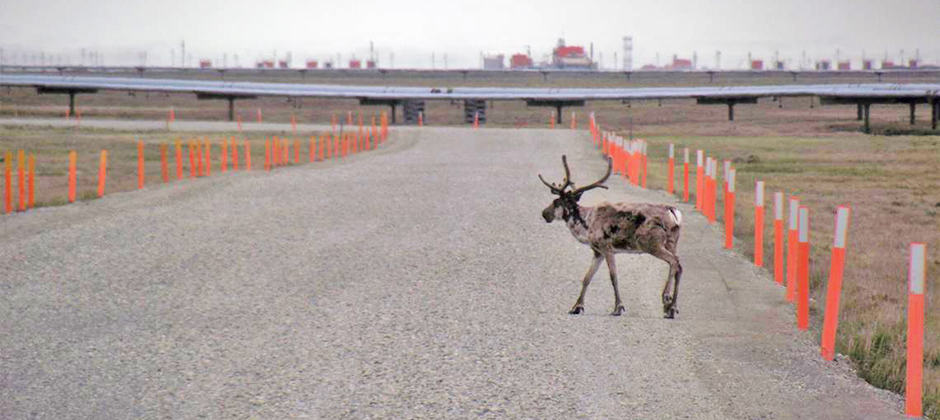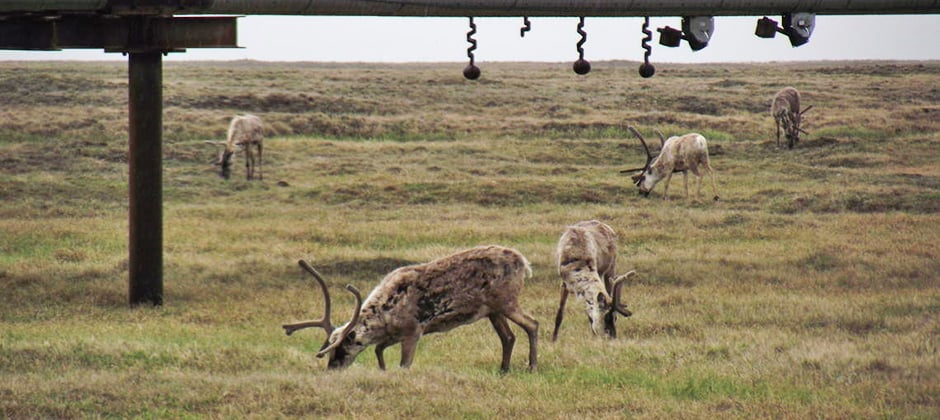Share this article
JWM: Decades on, Alaska caribou still avoid oil development
Caribou on Alaska’s North Slope continue to avoid oil infrastructure decades after it was put in place, especially during the calving season, according to a recent study This adds to a growing body of research that suggests caribou don’t become habituated to energy development, even in the long term.
“We don’t see evidence that caribou have habituated during the calving season, as our findings on caribou responses were similar to research done on this herd 30 years ago,” said TWS member Heather Johnson, a research wildlife biologist with the U.S. Geological Survey and the lead author of a study published recently in the Journal of Wildlife Management.
Barren ground caribou (Rangifer tarandus) herds migrate across vast stretches of Arctic North America, from Newfoundland to Alaska and much of the areas in between. Herds on the North Slope of Alaska can vary greatly in number — the Central Artic herd Johnson and colleagues studied has about 30,000 individuals while the neighboring Porcupine herd has an estimated 218,000.

Central Arctic Herd caribou cross a road within the Kuparuk oil field on the North Slope of Alaska during the summer mosquito harassment period. ©John Severson, U.S. Geological Survey
Most research on the effects of energy development on barren ground caribou in Alaska were conducted in the 1980s or 1990s, relatively soon after the Prudhoe Bay and Kapurak River oil fields were developed. Prudhoe Bay is the largest oil field in North America, according to ConocoPhillips.
But most of that research had been conducted via helicopter counts. Johnson and her colleagues wanted to revisit the topic using updated technology to see if the results differed about four decades after the oil fields had been built.
Johnson and her colleagues used GPS collar data collected between 2015 and 2017 to identify habitat selected by caribou, and then determined how the presence of development, such as well pads, roads and pipelines, altered caribou habitat use.
The Central Arctic herd typically calves during the first half of June in areas south of the oil fields. In late June, dense hordes of mosquitoes drive the ungulates and their calves north toward the Arctic Ocean where cooler, windier weather provides relief from the insects.
The data analysis showed that the Central Arctic herd avoided energy development most strongly during the calving season, even if it meant avoiding high quality habitat, Johnson said. Caribou reduced their use of habitat within three miles of development, she said, potentially due to female caribou mothers avoiding risks to newborn calves.
These numbers closely match research conducted decades earlier that showed caribou densities were less than expected within 2.5 miles from development. “Their response is effectively the same all these years later,” Johnson said.
But the researchers’ analysis showed that later in the summer, the irritation of summer insects may trump concerns about danger. In early July when mosquitoes are most abundant, caribou in the Central Arctic herd traveled north to the coast where there is more development. In this period, caribou still avoided oil development, but reduced their use of habitat within only 0.6 miles.
The influence of oil development on these caribou is of particular interest because energy development is expanding on the summer ranges of other caribou herds on Alaska’s North Slope, and there are significant concerns about the potential impacts.
More work needs to be done to determine the responses of caribou to different types of infrastructure and activities, Johnson said and whether there are any demographic effects.
“This work implies that we should reduce the overall footprint of development, especially in important habitat areas, if we want to minimize the behavioral impacts on caribou,” she said.
Header Image: Central Arctic Herd caribou within the Kuparuk oil field on the North Slope of Alaska during the summer mosquito harassment period. ©John Severson, U.S. Geological Survey.








